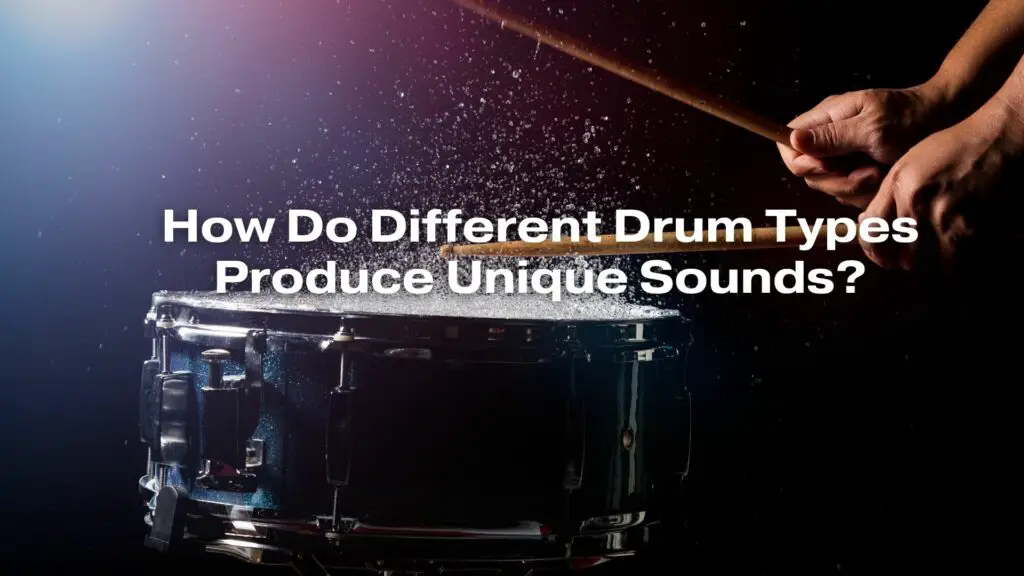Different drum types produce unique sounds due to their distinct construction, materials, and playing techniques. Each type of drum offers a specific tonal quality and character that contributes to the overall texture and rhythm of a musical piece. Here’s an overview of how various drum types produce their unique sounds:
- Kick Drum (Bass Drum):
- Sound: Kick drums produce a deep, low-frequency sound with a pronounced attack and sustain.
- Construction: They typically have a large, resonant chamber and a drumhead that’s tensioned for a deep and punchy sound.
- Playing Technique: Played with a foot pedal, kick drums create a foundational rhythm in many music genres.
- Snare Drum:
- Sound: Snare drums produce a sharp and crisp sound with a pronounced “crack” due to the metal or wire snares on the bottom drumhead.
- Construction: The shell is shallower compared to other drums, and the snare wires are often adjustable.
- Playing Technique: Struck with drumsticks, the snare drum provides a central rhythmic element and is known for its versatility.
- Tom-Tom Drums:
- Sound: Tom-tom drums produce a melodic, booming sound, varying in pitch based on their size and tuning.
- Construction: Tom-toms come in different sizes and are often used in sets to create melodic drum patterns.
- Playing Technique: Drummers play them with drumsticks, creating melodic and rhythmic fills and patterns.
- Hi-Hats:
- Sound: Hi-hats offer a crisp, shimmering sound with a range of tonal qualities depending on the tightness of the hi-hat cymbals.
- Construction: Composed of two cymbals that close together, the sound varies as they’re pressed tightly or separated.
- Playing Technique: Controlled by a foot pedal, hi-hats are played with drumsticks or by using the foot pedal to create open or closed sounds.
- Cymbals:
- Sound: Cymbals create bright, sustaining, and sometimes explosive sounds that contribute accents and crashes to drumming patterns.
- Construction: Made of metal alloys, cymbals can vary in size, shape, and thickness, which influences their sound.
- Playing Technique: Cymbals are struck with drumsticks, mallets, or brushes to add accents, crashes, and effects.
- Djembe (Hand Drum):
- Sound: Djembes produce warm, resonant, and earthy tones with a wide dynamic range.
- Construction: Djembes have a wooden shell with a goatskin drumhead tensioned by ropes.
- Playing Technique: Played with hands, djembes produce diverse sounds based on hand placement and technique, often used in African and world music.
- Bongos:
- Sound: Bongos offer sharp, high-pitched, and percussive sounds that are excellent for rhythmic accents.
- Construction: Bongos consist of two small drums, one smaller than the other, with different pitches.
- Playing Technique: Played with hands, bongos produce rhythmic patterns and accents in Latin and Afro-Cuban music.
- Tabla:
- Sound: Tabla drums produce complex and tuneful sounds with distinct high and low tones.
- Construction: Tablas are typically made of wood and have a specific tuning system.
- Playing Technique: Played with the fingers and palms, tablas create intricate and melodic rhythms, often found in Indian classical music.
- Steel Drums (Steel Pans):
- Sound: Steel drums have a melodic, bright, and Caribbean-style sound with multiple pitches across the instrument.
- Construction: Made from repurposed oil drums, steel drums have differently sized indentations to produce different pitches.
- Playing Technique: Played with rubber-tipped mallets, steel drums create joyful and melodic patterns.
In summary, the unique sounds of different drum types are a result of their construction materials, shape, size, and the techniques used to play them. Drummers and percussionists leverage these characteristics to create diverse rhythmic patterns, textures, and tonal qualities in music across various genres and traditions.


